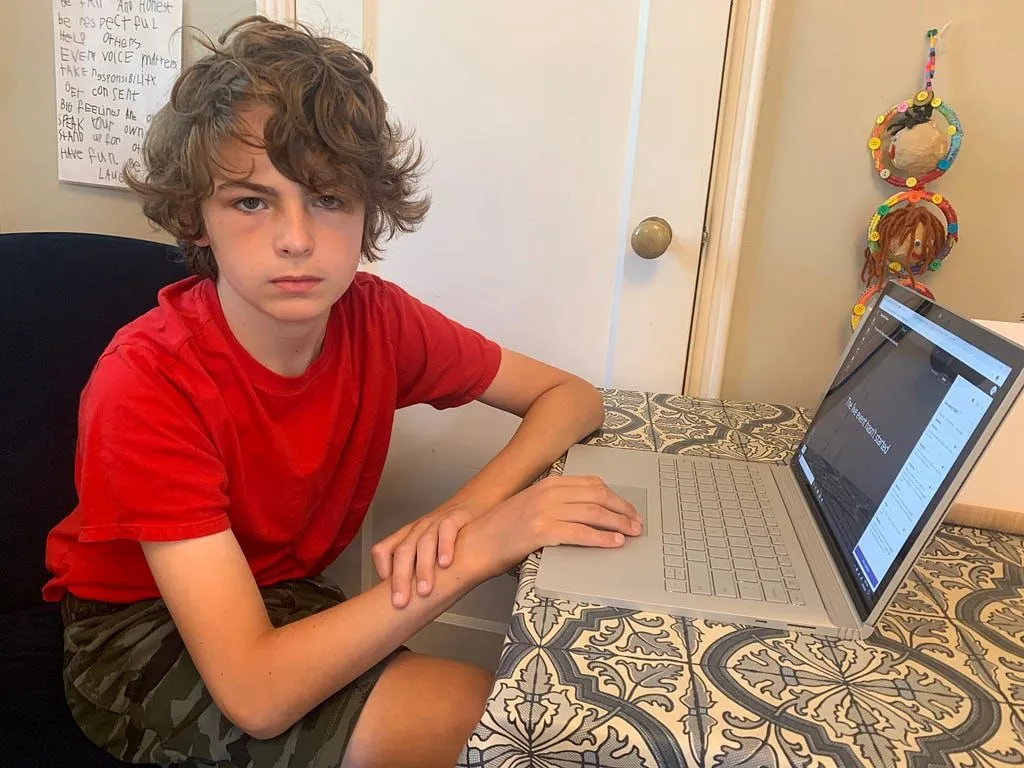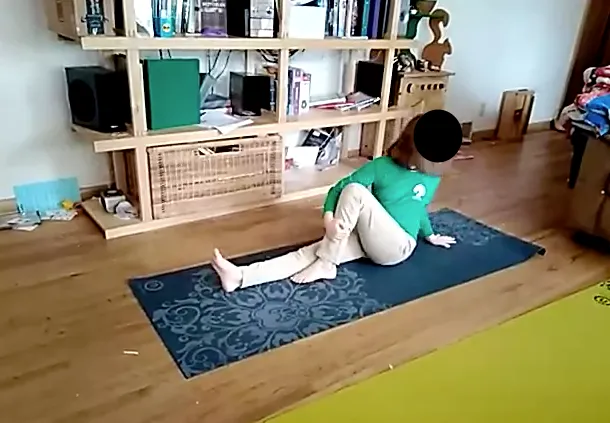Feb 23, 2023
Screenshot of student work during remote learning, received via a FERPA request of EdTech platforms being used by the child’s school. The EdTech company had access to this (and many other documents) about this child and her family. (Shared with permission).
Understanding the challenges around screen use in schools today is complicated. There are really three simultaneous problems :
The screens that kids bring to school in the form of personal devices (and the apps, social media sites, games, and platforms they can access on them);The screens that are provided or required by the school to do school (like 1:1 tablet or laptop programs);The EdTech platforms that kids are required to use, either on their personal devices OR the school-issued ones (such as learning management programs like Schoology or Google Classroom, or apps or platforms like IXL Math or Prodigy).
Here are just a few examples I’ve heard recently from parents about kids and present-day screen use in schools:
“My kid has a school laptop, but doesn’t know how to type ”Students have YouTube on school devices (because it can be used for “educational purposes”), and kids are accessing porn and other problematic contentStudents are not allowed to bring water bottles to school because they are “dangerous,” but they are given access to the internet through school-issued devicesTeachers expecting children to “focus on learning” while on a device, when, developmentally, kids’ brains are simply not capable of resisting the distractions on a device“Independent reading” on a laptop , instead of a book (for a child who doesn’t require tech to support a learning disability)EdTech platforms that track students and share that data with 3rd party advertisers
Even before the pandemic, children increasingly used screen-based technology in schools, and at younger and younger ages. While I believe, as always, in intentional use of tech , the stories I hear confirm over and over again that most schools aren’t using technology in intentional or developmentally appropriate ways .

My own kid, miserable during online remote learning classes
As a classroom teacher from 2003–2015, I witnessed the simultaneous rise of personal screen devices and social media and the increased expectation that teachers utilize tech-based platforms to manage teaching, planning, grading, and learning.
For my students using social media, I saw immediate effects in the classroom. They would arrive in the morning talking about what had happened on Facebook the night before, and who was being mean to whom, and who didn’t get invited to what. They were completely distracted by this, and it exacerbated the haves and have-nots even more– some students didn’t have social media, many didn’t have personal devices yet. The FOMO was real.
By the time I left the classroom in 2015, however, nearly 95% of my middle school aged students had personal devices– I surveyed them.
As a teacher, to be blunt, I hated using online planners and gradebooks. I loved my paper planner and the way I could see the entire week across two pages. My spiral-bound grade book, with its narrow-ruled lines, allowed me to quickly walk around the room and check off homework assignments.
Because of the new requirement to use tech for teaching, I now had double the work if I wanted to continue using paper planners and grade books, because I had to sit and enter it into a computer system. My students stopped coming up to me during breaks to ask about a missing assignment or a grade. Instead, we were supposed to encourage them to “look it up on” the platform. That seemed absurd to me– there was so much value in having the students advocate for themselves, make time to see me, understand how to communicate their needs or concerns.
It wasn’t just about the grade.
And this was nearly 10 years ago, before curriculum moved online.
For decades, schools were a relatively “screen-lite” environment. Parents and students could expect the occasional computer lab (Oregon Trail!) or typing class, but for the most part, homework was on paper and books were carried in backpacks. No one brought home a school laptop or logged into a digital platform to check homework assignments.
Screen use in school was on the uptick even pre-COVID. But the use of tech for remote learning during the pandemic was like dropping gasoline on slow-burning coals: suddenly, screens were used for everything: lessons, grading, reading, writing, math, research, play, free time, socializing, entertainment.
And not just for kids– parents, too.
During the spring of 2020, this made some sense. It was the lifeboat we needed to stay connected while we figured out what this all meant. But lifeboats aren’t meant to be long-term housing , and yet, here we are, three years later, still over-utilizing many of these same platforms.
There are lots of problems with using screen-based technology for learning. I could write an entire book about it (and indeed intend to).
Today, however, I want to bring your attention to the data and privacy side of all this technology use in schools. I know– “data” is such a boring word and “Google knows everything we’re doing anyway, doesn’t it?”
So why should we care?
Because at the end of the day, very few parents are aware of what happens to the data that is generated when your child uses technology for school. Where does it go? What happens to it? Who keeps it? What do they do with it?
A recent report called “ The K12 EdTech Safety Benchmark ” by Internet Safety Labs “found serious and disturbing risks to students’ personal information” by EdTech platforms used by schools:
Nearly all apps reviewed (96%) share children’s personal information with third parties. 28% are “non-education specific” (such as YouTube and Spotify) 23% expose children to digital ads, creating risk of leaking personal data to advertising companies
The problem is wide-reaching. The same report found that 40% of the schools average 125 technologies per school. One school used a whopping 1,411 different platforms.
Here are just a few examples of the types of data EdTech companies collect about children:
Geographic
location
Age
Birthdate
Religious affiliations
Sexual orientation
Mental health
status
Family
economic status
Grades and test scores
Behavior records
Number of logins
Keystrokes
Mouse movement

EdTech platforms captured and stored highly personalized information, such as baby pictures, during remote learning (shared with permission)
Many of these EdTech companies turn around and sell this information to data or ad brokers, who then use it to market products or target messaging to users. And data breaches are much more common than we’d like to think:
A young child’s social security number can be acquired on the dark web, credit cards opened in his name, and he won’t know he has ruined credit until he’s 18 years old; Another child’s behavior records might be shared with law enforcement, who use it to make predictions about potential future criminal behavior; Future employers might think twice before hiring someone who was depressed or suicidal in high school.
There are real-life, long-term harms with the way in which our children’s data is being utilized by companies who profit from it.
I recently testified before NASEM, the National Academies of Science, Engineering, and Medicine. My invitation to participate came through the activism I do with my colleagues through the FairPlay for Kids Screens in Schools Action Network. I’ve been working with this group since 2019, and they have become my friends and allies in this fight to protect children.
In the summer of 2020, a few of us co-founded The Student Data Privacy Project. Through that project, we asked parents to submit FERPA requests to their child’s school to see what kinds of data were being collected. What we found was pretty horrifying and just the tip of the iceberg. One parent volunteer received over 2,000 files from her child’s school, and it included images and videos like this (shared with permission):

Screengrab of video of child doing yoga for her school’s online PE class during remote learning, stored via an EdTech platform and shared with the parent only as a result of a FERPA request (shared with permission)
So what can parents do?
Parents can be a voice for change.
It’s always a good idea to start with your child’s classroom teacher. Ask non-judgmental questions about how technology is used in the classroom. Meet with your school administrators and ask them to show you the research behind their decisions to implement tech-based tools in the classroom. Testify at school board meetings and express your concerns.
You can do a FERPA request yourself! In fact, with my colleagues at the Student Data Privacy Project, we created a template for you to use. Fill out the request form here and you will automatically be emailed a template to fill out: https://www.studentdataprivacyproject.com/request-template.
The screens-in-schools piece of screentime makes life a lot more challenging for parents.
As I often say, it isn’t our fault that things are so challenging. But it is our responsibility to speak up, ask good questions, and advocate for safer learning-environments for all children.

